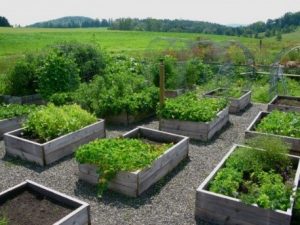Do you live in an “asphalt jungle”?
Would you like to do Greenscaping but your yard has been paved over? More and more people are reclaiming urban areas for gardens. Creating raised beds can be the answer. Ideally, impervious surface (such as asphalt or concrete) should be removed, but an alternative is to build raised beds over existing hard surfaces that have holes drilled for water drainage.
First steps.
- Review Planting Beds directions in this Guide.
- Decide the shape and size of your raised bed. Create a shape that lends itself to surrounding conditions. Consider ease of access. Remember that you want to reach all areas easily.
- Mark off the area and make drainage holes in the hard surface using an electric jackhammer with a pointed chisel drill bit (available from a rental center), or puncturing the surface with large cement nails and a hammer.
- Drill approximately nine holes per square foot, making sure you go all the way through.
Building the raised bed frame.
Select a non-toxic material such as untreated wood, modular blocks, or recycled plastic lumber. Also, check out the Internet for raised bed kits options. Remember to reinforce the corners of the structure with brackets or wood blocks for extra structural stability. Don’t use railroad ties or pressure treated boards that contain any creosote or arsenic.
The minimum depth for the bed should be 12”, but if you can accommodate 18”, your plant roots will be stronger and your plants healthier.
Once the frame is built.
- Lay down a weed blocking fabric liner on the hard surface to prevent soil loss.
- Secure the liner to the inside of the frame, going up the sides.
- Add a 2” layer of gravel for additional drainage and aeration.
- Lay a second layer of fabric and add your soil mixture.
A raised bed is an easy place to “go organic”.
Aim for a 50-50 mixture of clean loam and compost for a well-drained soil. Add grit sand for drainage (available at your local home center; start with about 10 lbs/square yard). In a raised bed, it is easy to change the soil composition. If you need more drainage, just add more sand. If a richer soil is needed, increase organic matter by adding manure, decomposed leaves, or more compost. Get your soil mixture right, and you will be rewarded with healthy, beautiful plants.
Time to plant.
Before planting, water the bed thoroughly to settle the soil. Soil should be about 2” below the top of the bed. Fill your bed with low maintenance, drought-tolerant plants (pgs. 12-14), and send your before and after photos to us (be more specific here, either give address or refer to it on another page) to be included in future Greenscapes materials. Here’s to your future garden!





